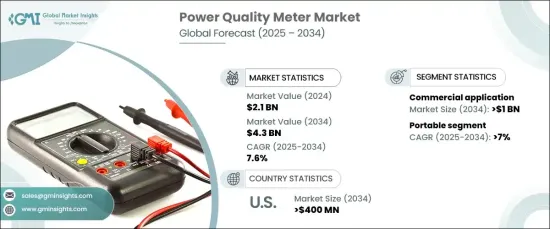
|
시장보고서
상품코드
1666934
전력 품질 측정기 시장 : 기회, 성장 촉진요인, 산업 동향 분석 및 예측(2025-2034년)Power Quality Meter Market Opportunity, Growth Drivers, Industry Trend Analysis, and Forecast 2025 - 2034 |
||||||
세계의 전력 품질 측정기 시장은 2024년에는 21억 달러가 되었고, 2025년부터 2034년까지의 CAGR은 7.6%를 나타내어 안정적인 성장률이 예측되고 있습니다.
이러한 성장은 다양한 분야에서 고감도 전자 기기에 대한 의존도가 높아지고 있는 것이 큰 요인이 되고 있습니다. 전력 품질 측정기는 전력 품질 분석기로도 알려져 있으며 배전 시스템의 전력 품질을 평가하는 특수 장치입니다. 이러한 장비는 네트워크의 전압, 전류 및 기타 장애와 관련된 문제를 감지하는 데 매우 중요합니다.

전력 품질은 전압 변동, 고조파, 과도 현상, 새그 등의 문제를 해결하고 전력의 신뢰성과 안정성을 보장하는 중요한 요소입니다. 전력 품질에 대한 규제와 표준이 계속 강화되고 있기 때문에 기업은 더욱 엄격한 요구 사항을 준수하고 시장 환경이 더욱 강화되고 있습니다. 이러한 장치는 보다 사용자 친화적인 인터페이스를 제공하기 위해 진화하고 있으며 데이터 액세스 및 구성이 쉬워지고 비즈니스 효율성이 크게 향상되었습니다.
| 시장 범위 | |
|---|---|
| 시작 연도 | 2024년 |
| 예측 연도 | 2025-2034년 |
| 시작 금액 | 21억 달러 |
| 예측 금액 | 43억 달러 |
| CAGR | 7.6% |
상업 부문은 크게 성장할 것으로 예상되며, 전력 품질 측정기 시장은 2034년까지 10억 달러 이상에 달할 것으로 예상됩니다. 모바일 애플리케이션과 웹 기반 플랫폼을 전력 품질 측정기에 통합함으로써 시장 성장이 더욱 촉진될 것으로 예상됩니다. 지속가능성과 에너지 효율성이 중요시되고 있는 가운데, 전력 품질 측정기는 에너지 낭비를 파악하고 전력 소비를 최적화하기 위한 필수적인 도구가 되고 있으며, 조직의 비용 절감과 환경 영향 저감에 기여하고 있습니다.
휴대용 전력 품질 측정기 분야도 2034년까지 연평균 복합 성장률(CAGR) 7% 이상으로 확대될 전망입니다. 전기 시스템의 복잡성, 특히 고감도 전자 장비의 사용 증가는 휴대용 전력 품질 측정기 수요를 촉진하고 있습니다. 이 계측기는 안정적인 고품질 전력 공급을 유지하고 장비 손상을 방지하고 가동 중지 시간을 줄이고 전반적인 효율을 높이는 데 필수적입니다. 또한 에너지 낭비를 파악하고 최소화하는데 중요한 역할을 하며 다양한 응용 분야에서 수요를 더욱 촉진하고 있습니다.
미국의 전력 품질 측정기 시장은 2034년까지 4억 달러 이상에 달할 것으로 예상됩니다. 전력 품질의 중요성에 대한 인식이 높아짐에 따라, 규제의 엄격화와 함께 산업계와 유틸리티자는 전력 품질의 저하가 기기나 업무에 미치는 악영향을 인식하게 되었습니다. 이러한 인식은 배전 시스템을 모니터링, 관리 및 개선할 수 있는 첨단 전력 품질 측정기에 대한 수요를 부추겨 시장 성장에 기여하고 있습니다.
목차
제1장 조사 방법과 조사 범위
- 시장 범위와 정의
- 시장 추계·예측 파라미터
- 예측 계산
- 데이터 소스
- 1차
- 2차
- 유료
- 공적
제2장 주요 요약
제3장 업계 인사이트
- 업계 생태계 분석
- 규제 상황
- 업계에 미치는 영향요인
- 성장 촉진요인
- 업계의 잠재적 리스크 및 과제
- 성장 가능성 분석
- Porter's Five Forces 분석
- 공급기업의 협상력
- 구매자의 협상력
- 신규 참가업체의 위협
- 대체품의 위협
- PESTEL 분석
제4장 경쟁 구도
- 서론
- 전략적 전망
- 혁신과 지속가능성의 전망
제5장 시장 규모와 예측 : 제품별(2021-2034년)
- 주요 동향
- 휴대용
- 패널 장착형
제6장 시장 규모와 예측 : 용도별(2021-2034년)
- 주요 동향
- 상업용
- 산업용
- 유틸리티
제7장 시장 규모와 예측 : 지역별(2021-2034년)
- 주요 동향
- 북미
- 미국
- 캐나다
- 멕시코
- 유럽
- 독일
- 프랑스
- 러시아
- 영국
- 이탈리아
- 스페인
- 네덜란드
- 오스트리아
- 아시아태평양
- 중국
- 일본
- 한국
- 인도
- 호주
- 뉴질랜드
- 말레이시아
- 인도네시아
- 중동 및 아프리카
- 사우디아라비아
- 아랍에미리트(UAE)
- 카타르
- 이집트
- 남아프리카
- 나이지리아
- 라틴아메리카
- 브라질
- 아르헨티나
제8장 기업 프로파일
- AF Smith Electric
- ABB
- Accuenergy
- Algodue Elettronica
- Delta Electronics
- Eastron Electronic
- Eaton
- Elspec
- Emerson Electric
- Fluke Corporation
- General Electric
- HIOKI EE CORPORATION
- LUMEL
- MB Control &Systems
- Megger
- Mitsubishi Electric Corporation
- MTE Power Quality
- PCE Instruments
- Rishabh Instruments
- Schneider Electric
- Siemens
- Vitrek
The Global Power Quality Meter Market was valued at USD 2.1 billion in 2024, with projections indicating a steady growth rate of 7.6% CAGR from 2025 to 2034. This growth is largely driven by the increasing reliance on sensitive electronic equipment across various sectors. Power quality meters, also known as power quality analyzers, are specialized devices that assess the electrical power quality in a distribution system. These instruments are crucial for detecting issues related to voltage, current, and other disturbances in the network.

Power quality is a critical factor that ensures the reliability and stability of electrical power, addressing issues such as voltage fluctuations, harmonics, transients, and sags. The ongoing tightening of power quality regulations and standards is further enhancing the market landscape as organizations seek to comply with stricter requirements. These devices are evolving to offer more user-friendly interfaces, allowing easier data access and configuration, which significantly improves operational efficiency.
| Market Scope | |
|---|---|
| Start Year | 2024 |
| Forecast Year | 2025-2034 |
| Start Value | $2.1 Billion |
| Forecast Value | $4.3 Billion |
| CAGR | 7.6% |
The commercial sector is expected to see substantial growth, with the market for power quality meters projected to surpass USD 1 billion by 2034. The increasing integration of mobile applications and web-based platforms into power quality meters is expected to further propel market growth. As sustainability and energy efficiency continue to gain importance, power quality meters are becoming essential tools for identifying energy wastage and optimizing power consumption, helping organizations reduce costs and their environmental impact.
The portable power quality meter segment is also expected to expand at a CAGR of over 7% through 2034. The growing complexity of electrical systems, particularly with the increasing use of sensitive electronic devices, is driving the demand for portable power quality meters. These instruments are essential in maintaining a stable and high-quality power supply, preventing equipment damage, reducing downtime, and enhancing overall efficiency. They also play a vital role in identifying and minimizing energy waste, further driving demand in various application areas.
In the U.S., the power quality meter market is anticipated to exceed USD 400 million by 2034. As awareness about the importance of power quality grows, along with stricter regulations, industries and utilities are increasingly recognizing the negative effects of poor power quality on equipment and operations. This awareness is fueling the demand for advanced power quality meters that can monitor, manage, and improve power distribution systems, contributing to market growth.
Table of Contents
Chapter 1 Methodology & Scope
- 1.1 Market scope & definitions
- 1.2 Market estimates & forecast parameters
- 1.3 Forecast calculation
- 1.4 Data sources
- 1.4.1 Primary
- 1.4.2 Secondary
- 1.4.2.1 Paid
- 1.4.2.2 Public
Chapter 2 Executive Summary
- 2.1 Industry synopsis, 2021 - 2034
Chapter 3 Industry Insights
- 3.1 Industry ecosystem analysis
- 3.2 Regulatory landscape
- 3.3 Industry impact forces
- 3.3.1 Growth drivers
- 3.3.2 Industry pitfalls & challenges
- 3.4 Growth potential analysis
- 3.5 Porter's Analysis
- 3.5.1 Bargaining power of suppliers
- 3.5.2 Bargaining power of buyers
- 3.5.3 Threat of new entrants
- 3.5.4 Threat of substitutes
- 3.6 PESTEL Analysis
Chapter 4 Competitive Landscape, 2024
- 4.1 Introduction
- 4.2 Strategic outlook
- 4.3 Innovation & sustainability landscape
Chapter 5 Market Size and Forecast, By Product, 2021 – 2034 (Units & USD Million)
- 5.1 Key trends
- 5.2 Portable
- 5.3 Panel mounted
Chapter 6 Market Size and Forecast, By Application, 2021 – 2034 (Units & USD Million)
- 6.1 Key trends
- 6.2 Commercial
- 6.3 Industrial
- 6.4 Utility
Chapter 7 Market Size and Forecast, By Region, 2021 – 2034 (Units & USD Million)
- 7.1 Key trends
- 7.2 North America
- 7.2.1 U.S.
- 7.2.2 Canada
- 7.2.3 Mexico
- 7.3 Europe
- 7.3.1 Germany
- 7.3.2 France
- 7.3.3 Russia
- 7.3.4 UK
- 7.3.5 Italy
- 7.3.6 Spain
- 7.3.7 Netherlands
- 7.3.8 Austria
- 7.4 Asia Pacific
- 7.4.1 China
- 7.4.2 Japan
- 7.4.3 South Korea
- 7.4.4 India
- 7.4.5 Australia
- 7.4.6 New Zealand
- 7.4.7 Malaysia
- 7.4.8 Indonesia
- 7.5 Middle East & Africa
- 7.5.1 Saudi Arabia
- 7.5.2 UAE
- 7.5.3 Qatar
- 7.5.4 Egypt
- 7.5.5 South Africa
- 7.5.6 Nigeria
- 7.6 Latin America
- 7.6.1 Brazil
- 7.6.2 Argentina
Chapter 8 Company Profiles
- 8.1 A.F. Smith Electric
- 8.2 ABB
- 8.3 Accuenergy
- 8.4 Algodue Elettronica
- 8.5 Delta Electronics
- 8.6 Eastron Electronic
- 8.7 Eaton
- 8.8 Elspec
- 8.9 Emerson Electric
- 8.10 Fluke Corporation
- 8.11 General Electric
- 8.12 HIOKI E.E. CORPORATION
- 8.13 LUMEL
- 8.14 M B Control & Systems
- 8.15 Megger
- 8.16 Mitsubishi Electric Corporation
- 8.17 MTE Power Quality
- 8.18 PCE Instruments
- 8.19 Rishabh Instruments
- 8.20 Schneider Electric
- 8.21 Siemens
- 8.22 Vitrek












